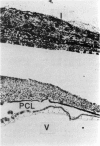Abstract
The posterior capsule has an important effect on the risk of postoperative bacterial endophthalmitis. In order to investigate whether the posterior capsule inhibited the spread of infection into the vitreous we performed extracapsular cataract extraction in both eyes of 10 primates. In one eye of each primate the posterior capsule was left intact and in the other eye a large posterior capsulectomy was performed. When the anterior chambers were challenged with equivalent inocula of Staphylococcus aureus, one of 10 eyes with an intact posterior capsule developed culture-positive vitreous infection. In contrast, nine of 10 eyes with a large posterior capsulectomy developed culture-positive vitreous infection. In a second experiment we investigated the effect of an intraocular lens on the barrier effect. Ten primates received extracapsular cataract extraction in both eyes and pseudophakic implantation. In one eye of each primate the posterior capsule was left intact and a J-loop monoplanar lens was implanted in the ciliary sulcus. In the other eye of each primate a large posterior capsulectomy was followed by implantation of a monoplanar, non-vaulted pseudophakos into the anterior chamber. None of the 10 eyes with a posterior capsule intact and a posterior chamber lens in place developed positive vitreous cultures or histopathological evidence of vitreous infection. Thus the presence of a posterior chamber lens did not appreciably compromise the barrier effect of the intact posterior capsule. 40% of the eyes with a large posterior capsulectomy and a non-vaulted pseudophakos in the anterior chamber developed culture-positive vitreous infection, and 60% of the eyes showed histopathological evidence of vitreous infection.
Full text
PDF





Images in this article
Selected References
These references are in PubMed. This may not be the complete list of references from this article.
- Bellows A. R., McCulley J. P. Endophthalmitis in aphakic patients with unplanned filtering blebs wearing contact lenses. Ophthalmology. 1981 Aug;88(8):839–843. doi: 10.1016/s0161-6420(81)34941-0. [DOI] [PubMed] [Google Scholar]
- Beyer T. L., Vogler G., Sharma D., O'Donnell F. E., Jr Protective barrier effect of the posterior lens capsule in exogenous bacterial endophthalmitis--an experimental primate study. Invest Ophthalmol Vis Sci. 1984 Jan;25(1):108–112. [PubMed] [Google Scholar]
- Beyer T. L., Vogler G., Sharma D., O'Donnell F. E., Jr Protective barrier effect of the posterior lens capsule in exogenous bacterial endophthalmitis: an experimental pseudophakic primate study. J Am Intraocul Implant Soc. 1983 Summer;9(3):293–296. doi: 10.1016/s0146-2776(83)80058-5. [DOI] [PubMed] [Google Scholar]
- Christy N. E., Lall P. Postoperative endophthalmitis following cataract surgery. Effects on subconjunctival antibiotics and other factrs. Arch Ophthalmol. 1973 Nov;90(5):361–366. doi: 10.1001/archopht.1973.01000050363005. [DOI] [PubMed] [Google Scholar]
- Clayman H. M., Jaffe N. S., Light D. S., Jaffe M. S., Cassady J. C. Intraocular lenses, axial length, and retinal detachment. Am J Ophthalmol. 1981 Dec;92(6):778–780. doi: 10.1016/s0002-9394(14)75629-6. [DOI] [PubMed] [Google Scholar]
- Forster R. K. Endophthalmitis. Diagnostic cultures and visual results. Arch Ophthalmol. 1974 Nov;92(5):387–392. doi: 10.1001/archopht.1974.01010010399005. [DOI] [PubMed] [Google Scholar]
- Jaffe N. S., Clayman H. M., Jaffe M. S. Cystoid macular edema after intracapsular and extracapsular cataract extraction with and without an intraocular lens. Ophthalmology. 1982 Jan;89(1):25–29. doi: 10.1016/s0161-6420(82)34855-1. [DOI] [PubMed] [Google Scholar]
- Keates R. H., Steinert R. F., Puliafito C. A., Maxwell S. K. Long-term follow-up of Nd:YAG laser posterior capsulotomy. J Am Intraocul Implant Soc. 1984 Spring;10(2):164–168. doi: 10.1016/s0146-2776(84)80101-9. [DOI] [PubMed] [Google Scholar]
- MAYLATH F. R., LEOPOLD I. H. Study of experimental intraocular infection. I. The recoverability of organisms inoculated into ocular tissues and fluids. II. The influence of antibiotics and cortisone, alone and combined, on intraocular growth of these organisms. Am J Ophthalmol. 1955 Jul;40(1):86–101. [PubMed] [Google Scholar]
- O'Day D. M., Jones D. B., Patrinely J., Elliott J. H. Staphylococcus epidermidis endophthalmitis. Visual outcome following noninvasive therapy. Ophthalmology. 1982 Apr;89(4):354–360. [PubMed] [Google Scholar]
- Olson J. C., Flynn H. W., Jr, Forster R. K., Culbertson W. W. Results in the treatment of postoperative endophthalmitis. Ophthalmology. 1983 Jun;90(6):692–699. doi: 10.1016/s0161-6420(83)34511-5. [DOI] [PubMed] [Google Scholar]




